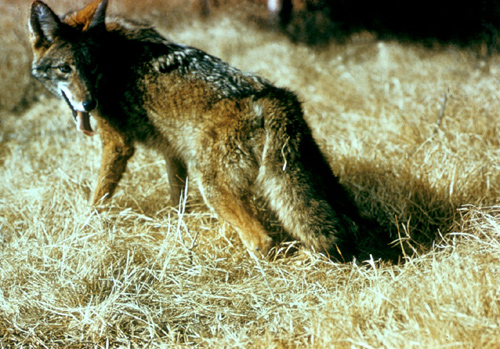Coyotes are native to the western plains of the US and have expanded eastwards. They have moved into Connecticut over the last century and are now common here. Coyotes have a grizzled coat of tan, grey, or brown fur with some black mixed in, usually with lighter fur underneath. They have a bushy tail 12 to 15 inches long with a black tip. Their legs are long and their muzzle is pointed. Their eyes are yellow, and they weigh 20 to 50 lbs.
Genetic evidence indicates that coyotes found in the east have interbred with Canadian gray wolves. This is believed to perhaps be a reason that eastern coyotes are larger than those found in the west.
Coyotes now range throughout the entire continental US, along the southern edge of Canada and up through western Canada into Alaska. They have adapted to many habitats and are found in woods, brushy regions and on the plains in the central US. They share residential areas with humans. They are active year round and most commonly are out and about at dawn and dusk.
Coyotes are carnivores, but are also opportunistic feeders. They will hunt solo or in coordination with a few partners. They eat smaller animals such as rodents, rabbits, birds, frogs and insects, and will also eat carrion, fruit or from human garbage. Although at times they will hunt a very young deer or a very weak adult animal, coyotes do not usually hunt white-tailed deer. However, a small pet is seen as just another prey animal by the coyote. Cats and small dogs unattended outside, especially after dark, are at risk when coyotes are present.
Mated Coyote pairs often remain monogamous for years, and sometimes for life. They mate from February to April and produce a litter of 1 to 9 pups in April to May. Both parents raise the pups.
Coyotes prepare a den for their puppies. They can dig their own burrow, enlarge another creature's abandoned burrow, or use a natural rock crevasse. The den might be reused for several years for raising their young each season. Otherwise, Coyotes don't maintain a permanent home.
Coyotes may travel alone, in mated pairs, or in small groups that are usually a set of parents and their pups. This family group is considered to be the basic social unit for Coyotes. Coyote choruses consisting of high-pitched yips and barks escalating into howls are usually made by a small family group but often sound like they are made up of many more animals than are actually singing. Coyote song at dusk is a lovely, yet slightly eery, sound. The purpose of this chorus is believed to be territorial communication with other Coyote groups as well as calling to or bonding with the members in a group. Family groups tend to go their separate ways in the fall, although sometimes a pair may remain together over winter.
Coyotes scent-mark their territories and are not tolerant of other Coyote groups or Red Foxes within them. The size of territories vary and tend to be much larger in wilderness areas. In areas shared with humans a Coyote may use an area of 10 or 12 square miles. In the wilderness it could be ranging across 60 square miles. Coyotes can run at 25 to 30 mph and sprint up to 40 mph.
Neat Fact
Coyotes can breed with domestic dogs, although this is rare. Some say it has never happened. Such offspring are called coydogs and are usually infertile. A female Coyote who has mated with a male domestic dog would be at a disadvantage because the dog doesn't stay to help raise the offspring. That is simply not the way for dogs. Such litters would have trouble surviving with only one parent.

